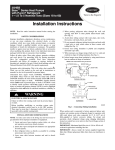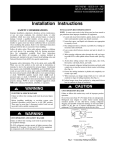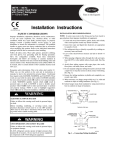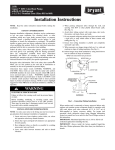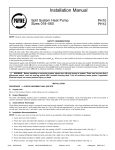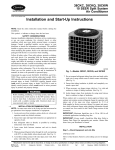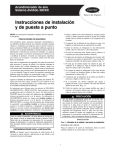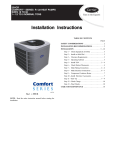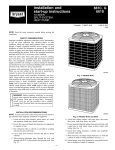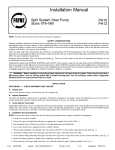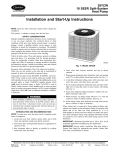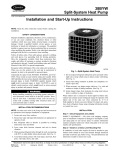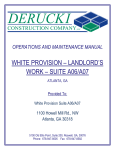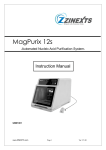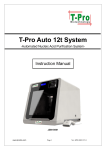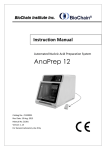Download Installation Manual
Transcript
Installation Manual Electric Heat Pump 018-060 Single Phase 048, 060 3 Phase PH13 NOTE: Read the entire instruction manual before starting the installation. SAFETY CONSIDERATIONS Improper installation, adjustment, alteration, service, maintenance, or use can cause explosion, fire, electrical shock, or other conditions which may cause death, personal injury, or property damage. Consult a qualified installer, service agency, or your distributor or branch for information or assistance. The qualified installer or agency must use factory-authorized kits or accessories when modifying this product. Refer to the individual instructions packaged with the kits or accessories when installing. Follow all safety codes. Wear safety glasses, protective clothing, and work gloves. Use quenching cloth for brazing operations. Have fire extinguisher available. Read these instructions thoroughly and follow all warnings or cautions included in literature and attached to the unit. Consult local building codes and National Electrical Code (NEC) for special requirements. . When you see this symbol on the unit and in instructions or manuals, be alert Recognize safety information. This is the safety-alert symbol to the potential for personal injury. Understand the signal words DANGER, WARNING, and CAUTION. These words are used with the safety-alert symbol. DANGER identifies the most serious hazards which will result in severe personal injury or death. WARNING signifies hazards which could result in personal injury or death. CAUTION is used to identify unsafe practices which would result in minor personal injury or product and property damage. NOTE is used to highlight suggestions which will result in enhanced installation, reliability, or operation. WARNING: Electrical Shock Hazard Failure to follow this warning can cause death or personal injury. Before installing or servicing system, always turn off main power to system. There may be more than 1 disconnect switch. Turn off accessory heater power if applicable. INSTALLATION RECOMMENDATIONS NOTE: In some cases noise in the living area has been traced to gas pulsations from improper installation of equipment. 1. Locate unit away from windows, patios, decks, etc. where unit operation sounds may disturb customer. 2. Ensure that vapor and liquid tube diameters are appropriate to capacity of unit. 3. Run refrigerant tubes as directly as possible by avoiding unnecessary turns and bends. 4. Leave some slack between structure and unit to absorb vibration. 5. When passing refrigerant tubes through the wall, seal opening with RTV or other pliable silicon-based caulk. (See Fig 1.) 6. Avoid direct tubing contact with water pipes, duct work, floor joists, wall studs, floors, and walls. 7. Do not suspend refrigerant tubing from joists and studs with a rigid wire or strap which comes in direct contact with tubing. (See Fig 1.) 8. Ensure that tubing insulation is pliable and completely surrounds vapor tube. 9. When necessary, use hanger straps which are 1 in. wide and conform to shape of tubing insulation. (See Fig 1.) 10. Isolate hanger straps from insulation by using metal sleeves bent to conform to shape of insulation. When outdoor unit is connected to factory-approved indoor unit, outdoor unit contains system refrigerant charge for operation with indoor unit of the same size when connected by 15 ft of field-supplied or factory accessory tubing. For proper unit operation, check refrigerant charge using charging information located on control box cover. IMPORTANT: Maximum liquid-line size is 3/8-in. O.D. for all residential applications including long line. IMPORTANT: Always install a liquid-line filter drier on any system using an existing field service lineset and/or existing indoor coil. Also, always use liquid line filter driers on burnout compressor replacements. Refer to Spec Sheet for appropriate part number. Obtain filter drier from your distributor or branch. Form: IM-PH13-01 Cancels: New Printed in U.S.A. 1-06 Catalog No. IM-PH13-01 A94208 Fig. 1—Connecting Tube Installation INSTALLATION PROCEDURE 1—CHECK EQUIPMENT AND JOB SITE A. Unpack Unit Move to final location. Remove carton taking care not to damage unit. B. Inspect Equipment File claim with shipping company prior to installation if shipment is damaged or incomplete. Locate unit rating plate on unit service panel. It contains information needed to properly install unit. Check rating plate to be sure unit matches job specifications. PROCEDURE 2—INSTALL ON A SOLID, LEVEL MOUNTING PAD If conditions or local codes require the unit be attached to pad, tie down bolts should be used and fastened through knockouts provided in unit base pan. Refer to unit mounting pattern in Fig. 2 to determine base pan size and knockout hole location. On rooftop applications, mount on level platform or frame 6 in. above roof surface. Place unit above a load-bearing wall and isolate unit and tubing set from structure. Arrange supporting members to adequately support unit and minimize transmission of vibration to building. Consult local codes governing rooftop applications. Roof mounted units exposed to winds above 5 mph may require wind baffles to achieve adequate defrost. Consult Low-Ambient Guideline for wind baffle construction. NOTE: Unit must be level to within ± 2° (± 3/8 in./ft) per compressor manufacturer specifications. PROCEDURE 3—CLEARANCE REQUIREMENTS When installing, allow sufficient space for airflow clearance, wiring, refrigerant piping, and service. Allow 30-in. clearance to service end of unit and 48 in. above unit. For proper airflow, a 6-in. clearance on 1 side of unit and 12 in. on all remaining sides must be maintained. Maintain a distance of 24 in. between units. Position so water, snow, or ice from roof or eaves cannot fall directly on unit. On rooftop applications, locate unit at least 6 in. above roof surface. PROCEDURE 4—OPERATING AMBIENT The minimum outdoor operating ambient in cooling mode is 55°F, and the maximum outdoor operating ambient in cooling mode is 125°F. The maximum outdoor operating ambient in heating mode is 66°F. —2— C 3⁄8″D. (9.53) TIEDOWN KNOCKOUTS (2) PLACES A B A94199 DIMENSIONS (IN.) UNIT SIZE 018—030 042—060 MINIMUM MOUNTING PAD DIMENSIONS 22-1/2 X 22-1/2 30 X 30 TIEDOWN KNOCKOUT LOCATIONS A B C 3-11/16 6-1/2 18-1/8 23-1/2 14-3/8 20 Fig. 2—Mounting Unit to Pad FEEDER TUBE STUB TUBE DEFROST THERMOSTAT A97517 Fig. 3—Defrost Thermostat Location PROCEDURE 5—ELEVATE UNIT CAUTION: Unit Damage Hazard Failure to follow this caution may result in unit component damage. Accumulation of water and ice in base pan may cause equipment damage. In areas where prolonged freezing temperatures are encountered, elevate unit per local climate and code requirements to provide clearance above estimated snowfall level and ensure adequate drainage of unit. PROCEDURE 6—EXPANSION DEVICE A hard shutoff, thermostatic expansion valve is required at the indoor section of the system for proper operation of these products. If the indoor section of the system is not equipped with a hard shutoff TXV, refer to Spec Sheet for the correct TXV kit to be installed. Follow the instructions in the kit for proper installation. PROCEDURE 7—CHECK DEFROST THERMOSTAT Check defrost thermostat to ensure it is properly located and securely attached. There is a liquid header with a brass distributor and feeder tube going into outdoor coil. At the end of 1 of the feeder tubes, there is a 3/8-in. O.D. stub tube approximately 2 in. long. (See Fig. 3.) The defrost thermostat should be located on stub tube. Note that there is only 1 stub tube used with liquid header, and on most units it is the bottom circuit. —3— TABLE 1—REFRIGERANT CONNECTIONS AND RECOMMENDED LIQUID AND VAPOR TUBE DIAMETERS (IN.) UNIT SIZE 018, 024 030, 036 042, 048 060 LIQUID Connection Diameter Tube Diameter 3/8 3/8 3/8 3/8 3/8 3/8 3/8 3/8 VAPOR Connection Diameter Tube Diameter 5/8 5/8 3/4 3/4 7/8 7/8 7/8 1-1/8 VAPOR (LONG LINE) Connection Diameter Tube Diameter 5/8 3/4 3/4 7/8 7/8 1-1/8 7/8 1-1/8 NOTES: 1. Tube Diameters are for lengths up to 50 ft horizontal or 20 ft vertical differential. For tubing lengths greater than 50 ft, consult the Application Guideline and Service Manual for Air Conditioners and Heat Pumps Using R-22 Refrigerant. PISTON BODY PISTON PISTON RETAINER STRAINER SWEAT/FLARE ADAPTER A97512 Fig. 4—Liquid Service Valve with Sweat Adapter Tube PROCEDURE 8—MAKE PIPING CONNECTIONS WARNING: Explosion Hazard Failure to follow this warning could result in death or personal injury. Relieve pressure and recover all refrigerant before system repair or final unit disposal to avoid personal injury or death. Use all service ports and open all flow-control devices, including solenoid valves. CAUTION: Unit Damage Hazard Failure to follow this caution may result in unit damage. DO NOT BURY MORE THAN 36 IN. OF REFRIGERANT TUBING IN GROUND. If any section of refrigerant tubing is buried, there must be a 6 in. vertical rise at service valve to avoid equipment damage. Refrigerant tubing lengths up to 36 in. may be buried without further special consideration. For lengths above 36 in., consult your local distributor. CAUTION: Unit Damage Hazard Failure to follow this caution may result in unit component damage. To prevent damage to unit or service valves observe the following: •Use a brazing shield. •Wrap service valves with wet cloth or use a heat-sink material. Outdoor units may be connected to indoor section using accessory tubing package or field-supplied refrigerant grade tubing of correct size and condition. For tubing requirements beyond 50 ft length or 20 ft vertical differential, substantial capacity and performance losses can occur. Following the recommendations in the Residential Split System Long-Line Application Guideline will reduce these losses. Refer to Table 1 for field tubing equivalent line length. If refrigerant tubes or indoor coil are exposed to atmosphere, they must be evacuated to 500 microns to eliminate contamination and moisture in the system. —4— A94025 Fig. 5—Line Power Connections A. Outdoor Unit Connected to Factory-Approved Indoor Unit Outdoor unit contains correct system refrigerant charge for operation with indoor unit of same size when connected by 15 ft of field-supplied or factory-accessory tubing. Check refrigerant charge for maximum efficiency. B. Refrigerant Tubing Connect tubing to fittings on outdoor unit vapor and liquid service valves. (See Table 1.) Use refrigerant grade tubing. Refer to appropriate section below for type of service valves installed on unit. C. Sweat Connection CAUTION: Unit Damage Hazard Failure to follow this caution may result in unit component damage. To avoid valve damage while brazing, service valves must be wrapped in a heat-sinking material such as a wet cloth. Remove plastic retainer holding outdoor piston in liquid service valve and connect sweat/flare adapter provided to valve. (See Fig. 6.) Connect refrigerant tubing to fittings on outdoor unit vapor and liquid service valves. Service valves are closed from factory and ready for brazing. After wrapping service valve with a wet cloth, tubing set can be brazed to service valve using either silver bearing or non-silver bearing brazing material. Do not use soft solder (materials which melt below 800°F). Consult local code requirements. Refrigerant tubing and indoor coil are now ready for leak testing. This check should include all field and factory joints. D. Final Tubing Check IMPORTANT: Check to be certain factory tubing on both indoor and outdoor unit has not shifted during shipment. Ensure tubes are not rubbing against each other or any sheet metal. Pay close attention to feeder tubes, making sure wire ties on feeder tubes are secure and tight. PROCEDURE 9—MAKE ELECTRICAL CONNECTIONS WARNING: Electrical Shock Hazard Failure to follow this warning could cause death or personal injury. To avoid personal injury or death, do not supply power to unit with compressor terminal box cover removed. Be sure field wiring complies with local and national fire, safety, and electrical codes, and voltage to system is within limits shown on unit rating plate. Contact local power company for correction of improper voltage. See unit rating plate for recommended circuit protection device. NOTE: Operation of unit on improper line voltage constitutes abuse and could affect unit reliability. See unit rating plate. Do not install unit in system where voltage or phase imbalance (3 phase) may fluctuate above or below permissible limits. NOTE: Use copper wire only between disconnect switch and unit. NOTE: Install branch circuit disconnect of adequate size per NEC to handle unit starting current. Locate disconnect within sight from and readily accessible from unit, per Section 440-14 of NEC. A. Route Ground and Power Wires Remove access panel to gain access to unit wiring. Extend wires from disconnect through power wiring hole provided and into unit control box. WARNING: Electrical Shock Hazard Failure to follow this warning can result in an electric shock, fire, or death. The unit cabinet must have an uninterrupted or unbroken ground to minimize personal injury if an electrical fault should occur. The ground may consist of electrical wire or metal conduit when installed in accordance with existing electrical codes. B. Connect Ground and Power Wires Connect ground wire to ground connection in control box for safety. Connect power wiring to contactor as shown in Fig. 5. —5— C. Connect Control Wiring Route 24v control wires through control wiring grommet and connect leads to control wiring. (See Fig. 6.) Use No. 18 AWG color-coded, insulated (35°C minimum) wire. If thermostat is located more than 100 ft from unit, as measured along the control voltage wires, use No. 16 AWG color-coded wire to avoid excessive voltage drop. All wiring must be NEC Class 1 and must be separated from incoming power leads. Use furnace transformer, fan coil transformer, or accessory transformer for control power, 24v/40va minimum. NOTE: Use of available 24v accessories may exceed the minimum 40va power requirement. Determine total transformer loading and increase the transformer capacity or split the load with an accessory transformer as required. HP THERMOSTAT HEAT PUMP TYPICAL FAN COIL 24 VAC HOT R R R 24 VAC COM C C C HEAT STAGE 2 W2 * W2 COOL/HEAT STAGE 1 Y INDOOR FAN G RVS COOLING O EMERGENCY HEAT E E W2 * W3 * Y G O * IF AVAILABLE A02325 Fig. 6—Generic Wiring Diagram (See Thermostat Installation Instructions for wiring specific unit combinations.) A97413 D. Final Wiring Check IMPORTANT: Check factory wiring and wire connections to ensure terminations are secured properly. Check wire routing to ensure wires are not in contact with tubing, sheet metal, etc. PROCEDURE 10—COMPRESSOR CRANKCASE HEATER When equipped with a crankcase heater, furnish power to heater a minimum of 24 hr before starting unit. To furnish power to heater only, set thermostat to OFF and close electrical disconnect to outdoor unit. A crankcase heater is required if refrigerant tubing is longer than 50 ft. PROCEDURE 11—INSTALL ELECTRICAL ACCESSORIES Refer to the individual instructions packaged with kits or accessories when installing. PROCEDURE 12—START-UP CAUTION: Unit Damage, Personal Injury Hazard Failure to follow this caution could result in unit damage or personal injury. •Do not overcharge system with refrigerant. •Do not operate unit in a vacuum or at negative pressure. •Do not disable low-pressure switch. In scroll compressor applications: •Dome temperatures may be hot. —6— CAUTION: Unit Damage, Personal Injury Hazard Failure to follow this caution may result in unit damage or personal injury. Wear safety glasses, protective clothing, and gloves when handling refrigerant and observe the following: •Back-seating service valves are not equipped with Schrader valves. Fully back seat (counterclockwise) valve stem before removing gage-port cap. •Front-seating service valves are equipped with Schrader valves. CAUTION: Environmental Hazard Failure to follow this caution may lead to fines or environmental impact. Federal regulations require that you do not vent refrigerant to atmosphere. Recover during system repair or final unit disposal. 1. Fully back seat (open) liquid- and vapor-tube service valves. 2. Unit is shipped with valve stem(s) front seated (closed) and caps installed. Replace stem caps after system is opened to refrigerant flow. Replace caps finger-tight and tighten with wrench an additional 1/12 turn. 3. Close electrical disconnects to energize system. 4. Set room thermostat to desired temperature. Be sure set point is below indoor-ambient temperature. 5. Set room thermostat to HEAT or COOL and fan control to ON or AUTO mode, as desired. Operate unit for 15 minutes. Check system-refrigerant charge. CAUTION: • 3-phase scroll compressors are rotation sensitive. To avoid equipment damage ensure that the compressor rotation is correct. • A flashing LED on phase monitor indicates reverse rotation. (See Fig. 7 and Table 2.) • This will not allow contactor to be energized. • Disconnect power to unit and interchange 2 field wiring leads on unit contactor. A. Sequence of Operation With power supplied to indoor and outdoor units, transformer is energized. COOLING On a call for cooling, thermostat makes circuits R-O, R-Y, and R-G. Circuit R-O energizes reversing valve, switching it to cooling position. On three phase models with scroll compressors, the units are equipped with a phase monitor to detect if the incoming power is correctly phased for compressor operation. (See Fig. 9 and Table 2.) If the phasing is correct, circuit R-Y energizes contactor, starting outdoor fan motor and compressor circuit. R-G energizes indoor unit blower relay, starting indoor blower motor on high speed. NOTE: If the phasing is incorrect, the contactor will not be energized. To correct the phasing, interchange any two of the three power connections on the field side. When thermostat is satisfied, its contacts open, de-energizing the contactor and blower relay. Compressor and motors should stop. NOTE: If indoor unit is equipped with a time-delay relay circuit, the blower runs an additional 90 sec to increase system efficiency. HEATING On a call for heating, thermostat makes circuits R-Y and R-G. If phasing is correct, circuit R-Y energizes contactor, starting outdoor fan motor and compressor. Circuit R-G energizes indoor blower relay, starting blower motor on high speed. A00010 Fig. 7—Phase Monitor Control —7— Table 2—Phase-Monitor LED Indicators LED STATUS No call for compressor operation Reversed phase Normal OFF FLASHING ON Should temperature continue to fall, R-W2 is made through second-stage room thermostat. Circuit R-W2 energizes relays, bringing on supplemental electric heat. If outdoor thermostat is used (field-installed option), only the first bank will be energized. Remaining bank of supplemental electric heat will be energized when outdoor temperature falls below outdoor thermostat setting. When thermostat is satisfied, its contacts open, de-energizing contactor and relays. All heaters and motors should stop. DEFROST The defrost control is a time/temperature control which includes a field-selectable (quick-connects located at board edge) time period between defrost cycles (30, 50, or 90 minutes), factory set at 90 minutes. Defrost mode is identical to cooling mode except that outdoor fan motor stops and second-stage heat is turned on to continue warming conditioned space. First the defrost cycle timer starts when the contactor is energized and a 24 volt signal is present on the T1 terminal. Then the defrost cycle begins when the cycle times out (30, 50, 90 min) and the defrost thermostat is closed. To initiate defrost, the defrost thermostat must be closed. This can be accomplished as follows: 1. Turn off power to outdoor unit. 2. Disconnect outdoor fan motor lead from OF2 on control board. (See Fig 8.) Tape lead to prevent grounding. 3. Restart unit in heating mode, allowing frost to accumulate on outdoor coil. 4. After a few minutes in heating mode, liquid line temperature should drop below closing point of defrost thermostat (approximately 30°F). OF1 ® US O1 R6 H9C1 C R14 R13 5. Short between speed-up terminals with a flat-bladed screw-driver. (See Fig 8.) This reduces the timing sequence to 1/256th of original time. C1 R8 R7 C4 C10 JW1 JW2 A29 C9 R9 D4 OF2 1 U1 R4 C13 R20 1 P2 Y P3 DFT T1 C C O HK32EA001 1 R11 R5 U3 JW3 R1 R2 R3 C7 D2 C5 D3 D6 C16 R28 C17 R26 K2 C19 D1 CEBD430524-01A 5501A D10 C2 D13 R21 K1 J2 1 P1 1 30 50 90 W1 J1 1 SPEEDUP O R W2 Y C A02001 Fig. 8—Defrost Control —8— TABLE 3—DEFROST CONTROL SPEED-UP TIMING SEQUENCE PARAMETER 30-minute cycle 50-minute cycle 90-minute cycle 10-minute cycle 5 minutes MINIMUM (MINUTES) 27 45 81 9 4.5 MAXIMUM (MINUTES) 33 55 99 11 5.5 SPEED-UP (NOMINAL) 7 sec 12 sec 21 sec 2 sec 1 sec (See Table 3.) 6. When you hear reversing valve change position, remove screwdriver immediately; otherwise, control will terminate normal 10-minute defrost cycle in approximately 2 sec. NOTE: Length of defrost cycle is dependent on the length of time it takes to remove screwdriver from test pins after reversing valve has shifted. 7. Unit will remain in defrost for remainder of defrost cycle time or until defrost thermostat reopens at approximately 80°F coil temperature of liquid line. 8. Turn off power to outdoor unit and reconnect fan motor lead to OF2 on control board. (See Fig. 8.) PROCEDURE 13—CHECK CHARGE Factory charge is shown on unit rating plate. To check charge in cooling mode, refer to Cooling Only Procedure on unit wiring and charging label. To check charge in heating mode, refer to Heating Check Chart Procedure. NOTE: If superheat or subcooling charging conditions are not favorable, charge must be weighed in accordance with unit rating plate ± 0.6 oz/ft of 3/8-in. liquid line above or below 15 ft respectively. A. Heating Check Chart Procedure To check system operation during heating cycle, refer to the Heating Check Chart on outdoor unit. This chart indicates whether a correct relationship exists between system operating pressure and air temperature entering indoor and outdoor units. If pressure and temperature do not match on chart, system refrigerant charge may not be correct. Do not use chart to adjust refrigerant charge. NOTE: When charging is necessary during heating season, charge must be weighed in accordance with unit rating plate ± 0.6 oz/ft of 3/8-in. liquid line above or below 15 ft respectively. EXAMPLE: To calculate additional charge required for a 25-ft line set: 25 ft - 15 ft = 10 ft X 0.6 oz/ft =6 oz of additional charge PROCEDURE 14—FINAL CHECKS IMPORTANT: Before leaving job, be sure to do the following: 1. Securely fasten all panels and covers. 2. Tighten service valve stem caps to 1/12-turn past finger tight. 3. Leave User’s Manual with owner. Explain system operation and periodic maintenance requirements outlined in manual. 4. Fill out Dealer Installation Checklist and place in customer file. CARE AND MAINTENANCE For continuing high performance and to minimize possible equipment failure, periodic maintenance must be performed on this equipment. Frequency of maintenance may vary depending upon geographic areas, such as coastal applications. —9— © 2005 Payne Heating & Cooling 7310 W. Morris St., Indianapolis, IN 46231 —10— imph1301 Catalog No. IM-PH13-01










